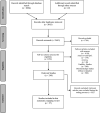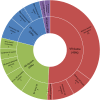Virtual and augmented reality applications to improve older adults' quality of life: A systematic mapping review and future directions
- PMID: 36339904
- PMCID: PMC9629585
- DOI: 10.1177/20552076221132099
Virtual and augmented reality applications to improve older adults' quality of life: A systematic mapping review and future directions
Abstract
Objective: The use of virtual reality and augmented reality to improve older adults' quality of life has rapidly increased in recent years. This systematic mapping review aimed to provide a comprehensive overview of existing research that identifies and classifies current virtual reality and augmented reality applications that enhance the quality of life of older adults to increase the understanding of the impact of these technologies.
Methods: To reach this objective, a systematic mapping review was conducted of the studies published between 2009 and 2020 in major scientific databases, such as IEEE Xplore, Web of Science, Scopus, and PubMed. A total of 57 studies were analyzed and classified into four main quality of life domains: physical, cognitive, psychological, and social well-being.
Results: The findings showed that virtual reality and augmented reality have found their places in many quality of life studies of older adults. Although virtual reality and augmented reality applications are notably growing in the physical and cognitive well-being domains in training and rehabilitation settings, they are still in the early stages of development in psychological and social well-being research as well as healthcare settings. Our findings also revealed that virtual reality games, particularly motion-based exergames, and 3D augmented reality systems are the most common virtual reality and augmented reality types among the reviewed studies. Moreover, balance and attention were the most prevalent physical and cognitive functions when using motion-based and immersive virtual reality exergames and augmented reality systems and games, respectively, while confidence and interaction were the most dominant psychological and social functions.
Conclusion: This mapping review provides a comprehensive overview of potential areas for further research in this field, thereby assisting researchers, technologists, and health practitioners in expanding this field of research.
Keywords: Augmented reality; healthcare; older adults; quality of life; rehabilitation; training; virtual reality.
© The Author(s) 2022.
Conflict of interest statement
The author(s) declared no potential conflicts of interest with respect to the research, authorship, and/or publication of this article.
Figures









References
-
- Bowling A. Quality of life in older age: What older people say. In: Mollenkopf H and Walker A (eds) Quality of life in old age. Dordrecht: Springer, 2007, pp.15–30.
-
- Hasan H, Linger H. Enhancing the wellbeing of the elderly: Social use of digital technologies in aged care. Educ Gerontol 2016; 42: 749–757.
-
- Vanleerberghe P, De Witte N, Claes Cet al. et al. The quality of life of older people aging in place: A literature review. Qual Life Res 2017; 26: 2899–2907. - PubMed
-
- Riva G, Gaggioli A, Villani D, et al. Positive technology for healthy living and active ageing. In: Active ageing and healthy living: A human centered approach in research and innovation as source of quality of life. IOS Press, 2014, pp.44–56. - PubMed
-
- Şahin DS, Özer Ö, Yanardağ MZ. Perceived social support, quality of life and satisfaction with life in elderly people. Educ Gerontol 2019; 45: 69–77.
Publication types
LinkOut - more resources
Full Text Sources

